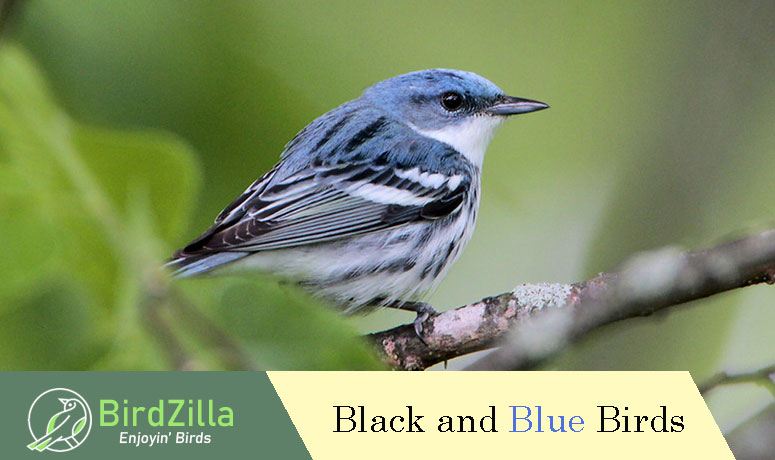
Black and blue is one of the more pleasing color combinations seen in birds. Although it’s not as frequent as yellow and brown, several birds have contrasting black and blue plumage.
A black and blue color combination can help birds blend in with dark, shaded vegetation. For male birds, these colors also attract mates. They aren’t the only ones who love to watch birds with black and blue feathers. We do too!
See 12 of these bird species with beautiful black and blue plumage below.
On this page
#12 Eurasian Magpie
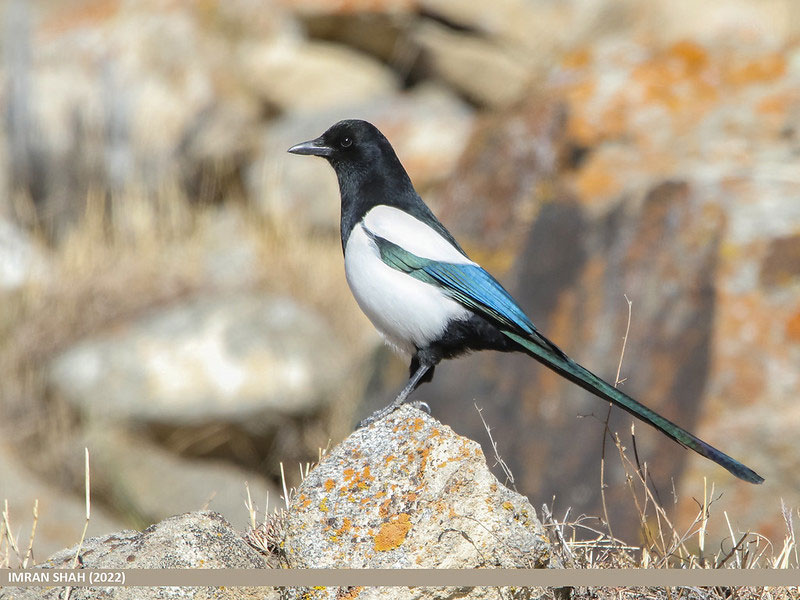
© Imran Shah
The Eurasian Magpie is a large, long-tailed, black and white bird. It has a stout black beak, and a black head, breast, and back. It also has black on the rump and under the tail. This contrasts with its bright white belly and shoulder. Eurasian Magpies have metallic blue iridescence on the wings and tail. In flight, we also see a large white patch on the rounded wings.
Within most of its range, no other bird has such a bold, black and white pattern, and long tail.
Eurasian Magpies live in woodlands, parks, in urban areas, and many other habitats. They occur throughout Europe and range south to Iran, and east to Mongolia, China, and eastern Russia.
#11 Blue Grosbeak
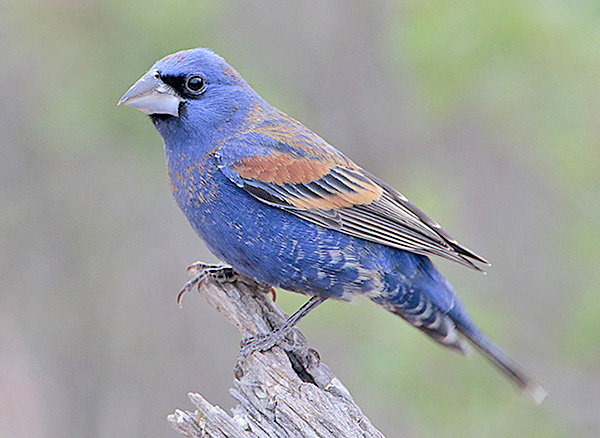
Photograph © Greg Lavaty.
The Blue Grosbeak is a hefty, sparrow-like bird with a large, conical bill. The male is a deep gorgeous blue with chestnut markings on black wings. It also has some black on the face and in the tail. The female Blue Grosbeak is mostly reddish-brown with just a hint of blue.
This species can be told from the Indigo Bunting by its chestnut wing bars and larger bill. It lives in brushy habitats and weedy fields in the southern half of the USA and in the Great Plains. The Blue Grosbeak also lives in Mexico and Central America.
#10 Black-Throated Blue Warbler
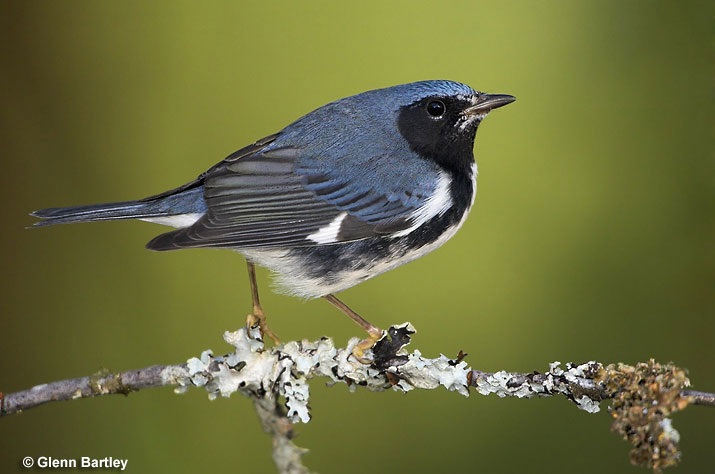
The male Black-throated Blue Warbler is a small warbler with gray-blue upperparts, and black face and throat. It also has black wings with a small white spot, and a blackish tail. The rest of the underparts are white with black sides.
The female Black-throated Blue Warbler is mostly buff and dark brown with a small white spot in the wing, and some pattern on the face.
The only other species that look anything like this distinctive bird are the Siberian Blue Robin, and the Blackthroat. Both of these birds live in Asia, very far from the range of the Black-throated Blue Warbler.
This species breeds in the Great Lakes region east to Nova Scotia and south in the Appalachians. It mostly winters in the Caribbean.
#9 Blue Bunting
The Blue Bunting is a sparrow-sized bird with a deep, black, finch-like bill. The male is dark blue with light blue highlights on the head, shoulder, and rump. It also has black on the face, and in the wings and tail. Females are rich, reddish-brown with a black eye and bill.
The male can be told from the Indigo Bunting by its deeper, darker bill. The female Blue Bunting is recognized by her uniform plumage and dark bill.
This species loves the undergrowth of tropical, brushy habitats. On occasion, it occurs in southern Texas. However, most Blue Buntings live in the lowlands of Mexico and parts of northern Central America.
#8 Tree Swallow
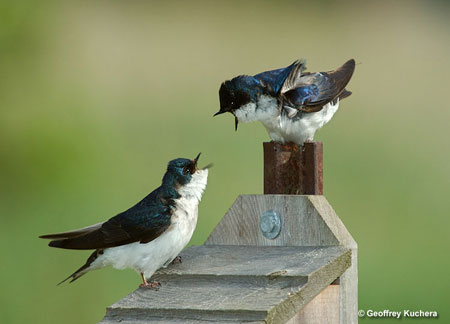
tree swallow
The Tree Swallow is a small to medium-sized swallow species. It has metallic, green-blue upperparts, and white underparts. This swallow also has a small black bill, a bit of black on the face, long black wings, and a forked black tail.
Tree Swallows are the only swallow in North America with solid, green-blue upperparts and white underparts. These friendly and beautiful birds are common around lakes, rivers, and other wetlands. They breed in Alaska, Canada, and much of the northern USA. Tree Swallows also winter from South Carolina and California to Central America.
#7 Shining Honeycreeper
The Shining Honeycreeper is a tiny tanager species of rainforest in Central America. The male is deep blue with jet black in front of the eye, on the throat, and on the wings and short tail. It also has a long, curved, black bill, and bright yellow legs and feet. The female Shining Honeycreeper is shaped like the male but is green above and pale below with green-blue streaks.
This tiny bird lives in rainforests from southern Mexico to eastern Panama and adjacent Colombia. It is the only small bird in its range with yellow legs and a curved beak.
#6 Bee Hummingbird
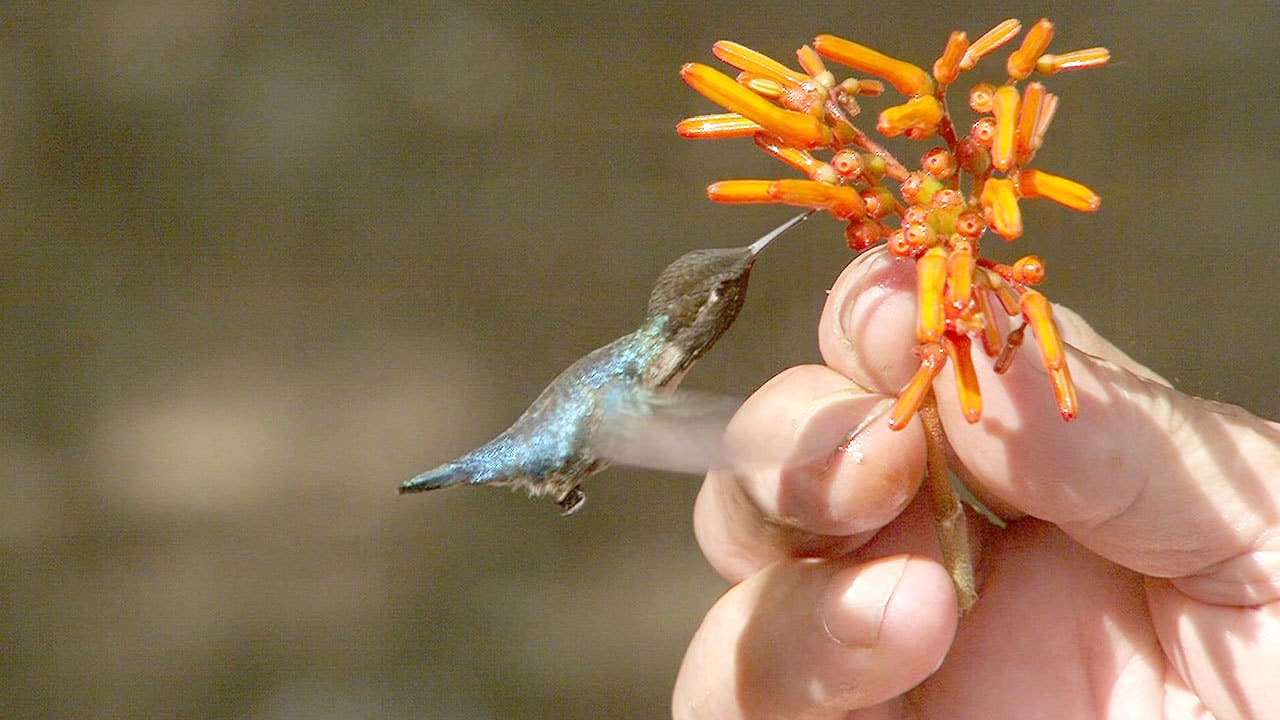
Image credits: https://www3.nhk.or.jp
The Bee Hummingbird is the smallest bird in the world. About the same size as a large bug, this hummingbird has green-blue above and on the sides, and white underparts. The male has metallic, magenta on the head and throat, while the female lacks these colorful feathers.
Learn more: Bird Facts and Statistics
Both sexes of the Bee Hummingbird have black wings, a beady black eye, a black bill, and some bits of black on the head. This special little bird only lives in Cuba. In this limited range, it is the only tiny hummingbird species with white underparts, and a small white spot behind the eye.
#5 Cerulean Warbler
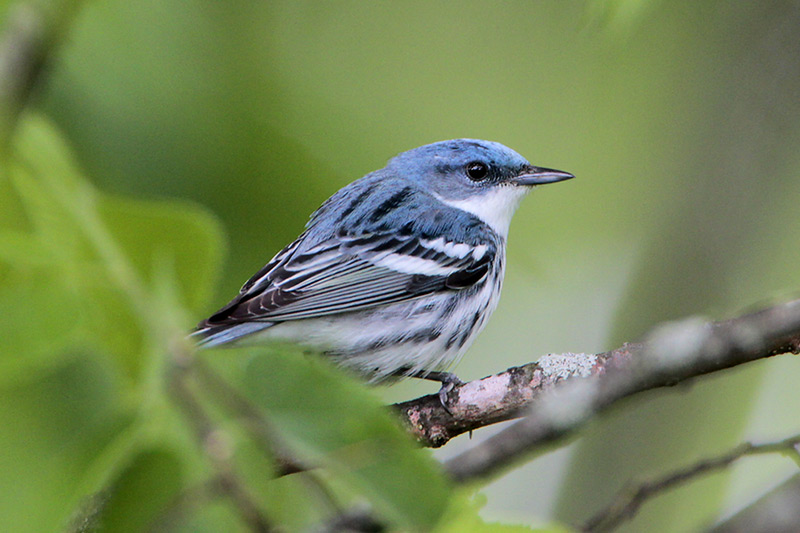
Photograph © Greg Lavaty.
The Cerulean Warbler is a small, pale warbler of the canopy. Male Cerulean Warblers are deep, cerulean blue above, and white below. They also have a narrow, gray-blue “necklace”, gray-blue streaks on the sides, and a small white eyebrow. This species has two white wing bars on blackish wings, a black bill, and a blue, black, and white tail.
Cerulean Warblers live in the upper levels of mature deciduous forests. It occurs from Minnesota and Missouri east to New York and southern Ontario. This species reaches its southern limit in Tennessee and Arkansas.
#4 Common Grackle
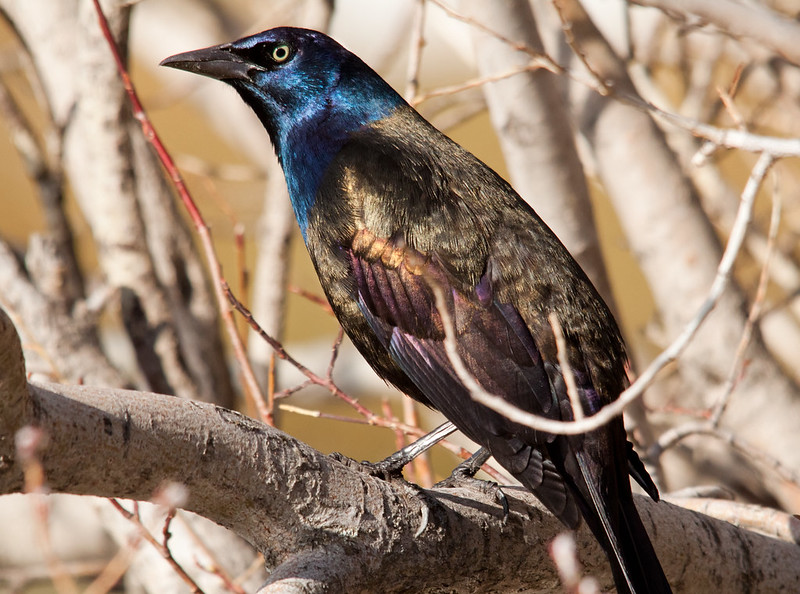
© Shawn McCready
The Common Grackle is a black bird with a long, wedge-shaped tail, pale eye, and strong black bill. It has metallic dark blue colors on its head, and can have blue-purple, dark green, or bronze highlights on its body.
Common Grackles are easily recognized by their black plumage with metallic iridescence, long, wedge-shaped tail, and pale eye. They flock together and are common in farm fields, suburbs, and other open habitats. This species occurs in central and eastern Canada, and the eastern USA west to Montana.
#3 Purple Martin
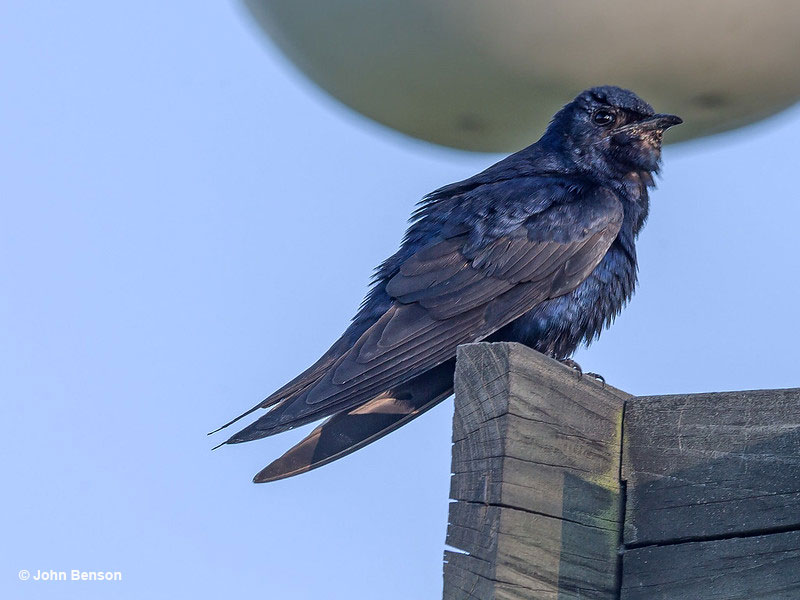
The male Purple Martin is a big, dark swallow species. It has dark blue and purple iridescence on otherwise blackish plumage. In general, these shiny colors are found on the head and body while the forked tail and long wings are black.
This hefty swallow is a common sight around lakes and various places with “martin houses”. Purple Martins use these structures for nesting and occur wherever they are present. People have placed them near housing, lakes, and other places in parts of southern Canada and the eastern USA. In the west, Purple Martins are less common and only nest in tree cavities near the coast and in some montane regions.
#2 Indigo Bunting
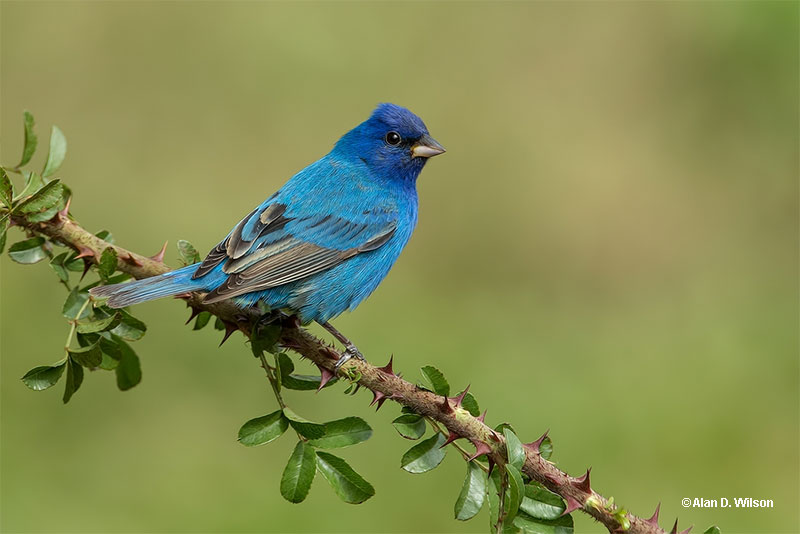
© Alan D. Wilson
The male Indigo Bunting is a small, sparrow-sized bird with deep, beautiful blue plumage. It also has black in the wings and tail, and has a bit of black in front of the eye. This bird has a smallish, conical gray and black bill, and gray legs.
In certain lighting, male Indigo Buntings can look entirely black. This is no illusion; the blue in this (and other) species is produced by the interaction of light waves with the structure of its feathers. In low light situations, they can appear more black than blue.
In most of its range, the Indigo Bunting is the only small, mostly blackish-blue or blue, finch-like bird with a blue-gray bill. They love brushy second growth in parts of southern Canada, the eastern USA, and the southwestern USA.
#1 Steller’s Jay
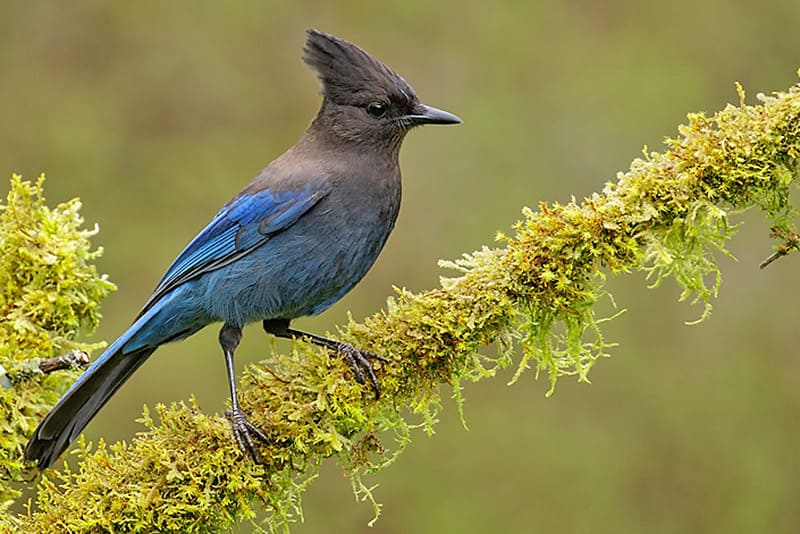
Photograph © Glenn Bartley.
Steller’s Jay is a fairly large bird with a tall, pointed crest. It’s head and throat are dull black with some white markings. The back and breast are dark blue-gray, and the rest of the bird is bright blue. It also has some dark barring in the wings and tail.
In their range, Steller’s Jays are easy to recognize. They are the only crested, black and blue jay in western North America. These noisy jays prefer coniferous forests and woodlands, but they aren’t shy. They also visit feeders and explore campgrounds to look for snacks.
Frequently Asked Questions
What kind of bird is black and blue?
Many bird species are black and blue. Two of these species are the Steller’s Jay and Indigo Bunting.
What bird looks like a blue jay but black?
The Steller’s Jay. This crested jay species with blue and black plumage replaces the Blue Jay in western states and provinces.
What bird is black with a blue back and wings?
The Steller’s Jay is a dark jay with a black head, blue back, and pretty, blue wings.
What bird is royal blue with a black head?
Steller’s Jays are royal blue with black heads.


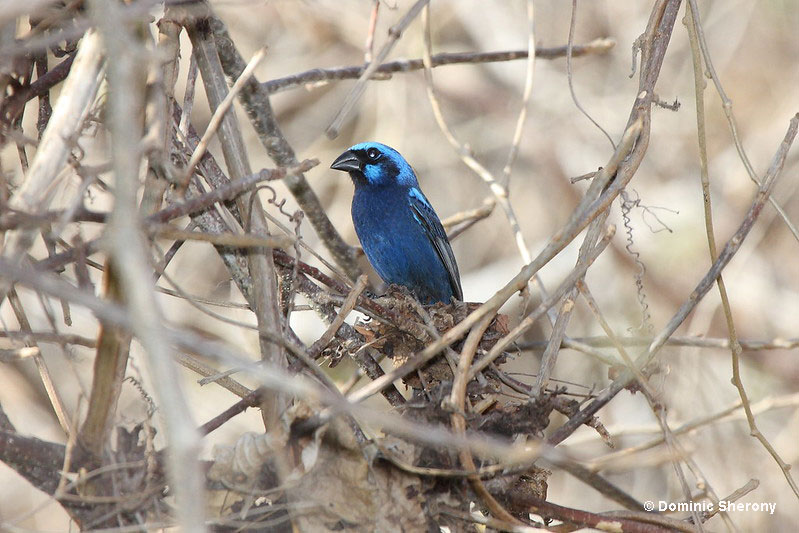
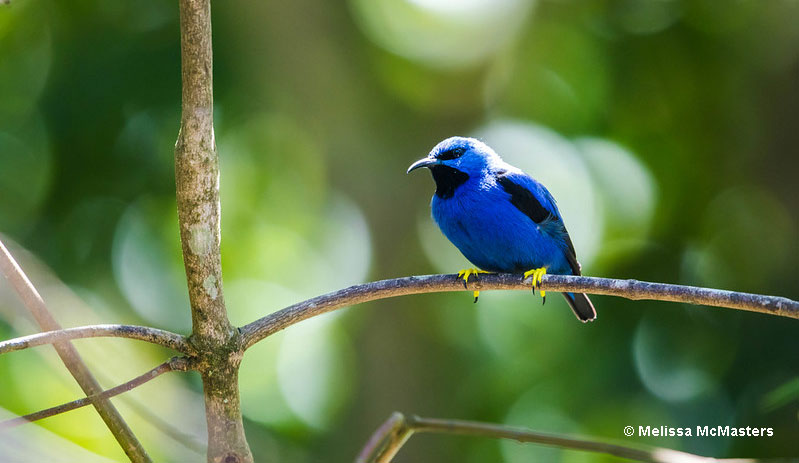
Lisa
Friday 16th of June 2023
Hi I live is southeastern Wisconsin, recently we just moved from one location yo another and have opportunity to enjoy the birds, we are trying to figure out what a bird with blue on his head and and back of his body with combo of white/black on his tail and underside. He has a squared head with a long beak and tail. Its a big bird but sleek. Can you help us to identify this bird.
Patrick O'Donnell
Monday 19th of June 2023
@Lisa- Glad to hear you are enjoying the birds in Wisconsin! Your mystery bird sounds like it could be a Blue Jay. However, without a photo, it's hard to truly know what it is. If you can send us a link with a picture of the bird, we would love to see it!